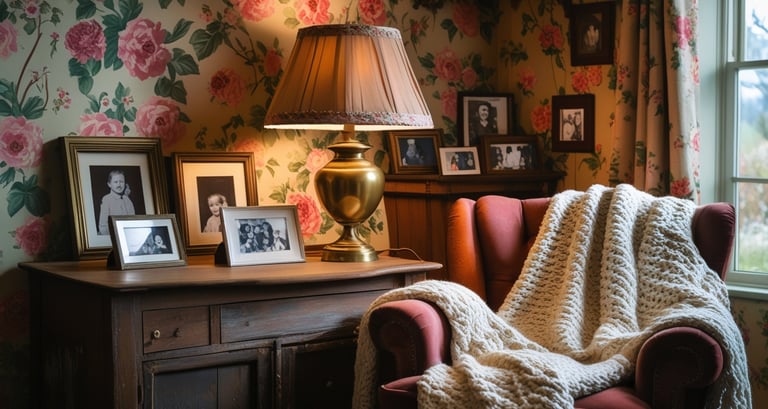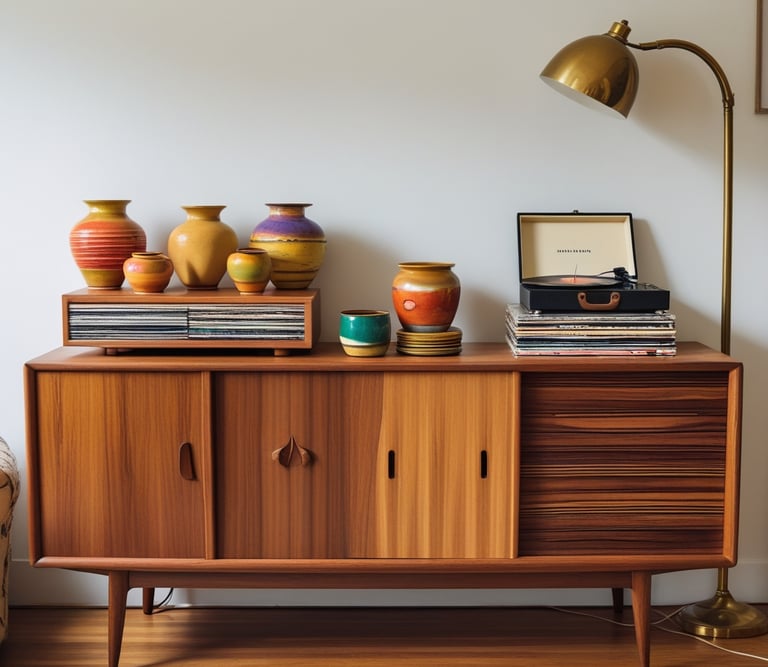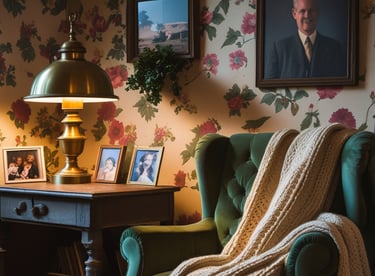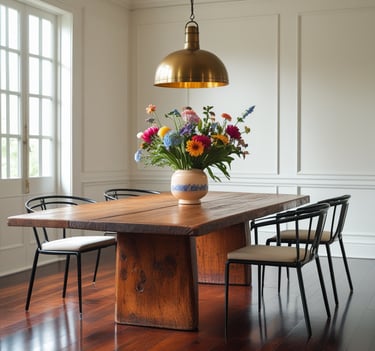Nostalgia Decor: Personal Design Trend
Nostalgia Decor: Personal Design Trend, Discover the deeply personal trend of nostalgia decor. Learn how to incorporate vintage elements into your home for a comforting, memory-evoking space.
DIY & HOME IMPROVEMENTS
Sophia Reed
8/5/20259 min read


Nostalgia Decor: Why Everyone's Bringing Grandma's Style Back Home
You know that feeling when you walk into someone's house and it just feels... right? Like you could curl up on their couch with a cup of tea and stay for hours? That's what I'm talking about when I mention nostalgia decor. It's not some fancy design term – it's simply decorating with pieces that make your heart happy because they remind you of good times.
I've been helping people decorate their homes since 1994, and let me tell you, this trend hits different than anything I've seen before. People aren't just buying pretty things anymore. They're hunting down that exact shade of green their mom painted the kitchen cabinets, or desperately searching flea markets for a lamp that looks like the one from their childhood bedroom.
What's This All About Anyway?
Forget everything you think you know about interior design rules. Nostalgia decor throws the rulebook out the window. Instead of asking "What's trendy?" people are asking "What makes me feel like myself?"
My client Sarah recently brought me a hideous orange ceramic owl from the 1970s. Her words, not mine! But you should have seen her face light up when she told me about how her grandmother displayed it on the mantle, and how she'd always promised Sarah it would be hers someday. That ugly owl? It's now the centerpiece of her living room, and guests always comment on how welcoming her space feels.
This whole movement started when people got tired of those sterile, Instagram-perfect homes that looked like nobody actually lived in them. COVID made it worse – suddenly everyone was stuck at home, staring at their bland walls, craving something real.
Your Stuff Tells Your Story
Here's what I love most about this trend – no two homes look alike. I worked with twins last year, identical twins who grew up in the same house, and their nostalgic spaces couldn't be more different. One gravitated toward their father's old record collection and dark wood furniture. The other fell in love with their mother's collection of blue willow china and wanted everything light and airy.
Same childhood, completely different memories that stuck with them.
That's because nostalgia isn't really about the objects themselves. It's about the feelings attached to them. The smell of your dad's leather chair. The way afternoon sunlight hit your grandmother's lace curtains. The sound of your mom humming while she cooked dinner on that avocado green stove.


Where to Even Start
Look, I get it. Walking into an antique store can feel overwhelming when you're trying to figure out what speaks to you. Here's my advice: start with what you already have.
Dig through your parents' attic. Ask your relatives if they have anything they were planning to donate. You'd be amazed what treasures are hiding in basements and storage units. Last month, a client found her great-aunt's entire set of pink Depression glass wrapped in newspaper from 1987. Her great-aunt had been saving it "for special occasions" and never used it. Now it's displayed in my client's kitchen window, catching the morning light every day.
Sometimes the best nostalgic pieces aren't the obvious ones. Maybe it's not the fancy china cabinet, but that weird little ceramic cat your sister made in high school pottery class. The one that's been sitting on your shelf for twenty years because you couldn't bear to throw it away.
The Wallpaper Situation
Can we talk about wallpaper for a minute? I know it scares people, but hear me out. Wallpaper is having a moment, and not just any wallpaper – the kind your grandmother would have chosen. Bold florals, geometric patterns from the 60s, those tiny floral prints from the 80s that everyone swore they'd never want to see again.
My client Jennifer was adamant she hated floral wallpaper. "Too busy," she said. "Too old-fashioned." Then she found a roll of vintage rose wallpaper at an estate sale that looked exactly like the powder room in her childhood home.


You don't have to go full-room with vintage patterns if that feels like too much. Try an accent wall, or even just frame a piece of vintage wallpaper as art. Sometimes a little goes a long way.
Furniture That's Seen Some Life
Mid-century modern pieces are everywhere right now, but here's the thing – don't buy them just because they're trendy. Buy them because they remind you of something or someone important.
I have clients who hunt for specific pieces from their childhood. Not just any teak credenza will do – it has to be the right shade, the right size, with those particular brass handles that click just so when you open the drawers. These aren't just furniture shoppers; they're memory hunters.
But here's a secret: you don't need authentic vintage pieces to get that nostalgic feeling. Sometimes a reproduction works just as well, especially if you're working with a tight budget. What matters is how the piece makes you feel, not whether it was actually made in 1965.
The key is mixing these statement pieces with modern elements so your home doesn't feel like a time capsule. That vintage credenza looks great with contemporary artwork hanging above it. Those old brass lamps work beautifully on modern side tables.
Colors That Give You Feelings
Remember when everyone's kitchen was harvest gold or avocado green? Those colors are coming back, but not in the same overwhelming way. People are using them as accents – a mustard yellow throw pillow here, a burnt orange vase there.
These aren't just trendy colors; they're emotional colors. They remind us of specific times and places in ways that today's grays and whites simply can't. There's something about that particular shade of teal from the 1950s that just hits different than any modern blue-green you can find at the paint store.
I always tell clients to test colors in different lights before committing. That perfect shade of pink you remember from your childhood bedroom might look completely different in your current home's lighting. Sometimes you have to adjust to get the feeling right, even if the exact color isn't perfect.
Making It Work Without Looking Like a Museum




The biggest mistake I see people make is going too hard on one era. Your home isn't a themed restaurant – it needs to work for your actual life. That means your grandmother's dining set is beautiful, but you still need comfortable seating and adequate lighting for homework help and family game nights.
Balance is everything. Use vintage pieces as focal points, then support them with modern functionality. Keep that gorgeous antique desk, but pair it with an ergonomic office chair and good task lighting. Display your collection of vintage cookbooks, but make sure you have modern appliances that actually work.
I also recommend the "one room at a time" approach. Don't try to transform your entire house overnight. Start with one space – maybe your bedroom or a small reading nook – and get comfortable with how nostalgic elements feel in your daily life before expanding to other areas.
The Emotional Stuff Nobody Talks About
Let's be real about something: decorating with meaningful objects can be emotionally intense. I've had clients break down in tears while sorting through inherited items. I've seen marriages strained over disagreements about whose family heirlooms get displayed where.
This process forces you to confront your relationship with your past, your family, and your own identity. It's not always pretty, but it's usually worth it.
Some practical advice: if an item brings up sad memories, you don't have to display it. You can keep it stored safely without guilt. If family members disagree about who should have something, consider taking turns displaying it or finding creative ways to share.


And remember – you're not running a museum. If something doesn't work in your space or your lifestyle, it's okay to let it go. The goal is to surround yourself with things that make you happy, not things that make you feel obligated or overwhelmed.
Budget Reality Check
Good news: nostalgic decorating doesn't have to cost a fortune. Some of my most successful projects have been done on shoestring budgets using creativity and patience.
Estate sales are gold mines, but you have to be strategic. Go early for the best selection, or go late for the best prices. Bring cash and be prepared to walk away if something doesn't feel right. Remember, you're looking for pieces that speak to you personally, not just good deals.
Thrift stores require more patience but can yield amazing finds. I found a lamp identical to one from my own childhood bedroom at Goodwill for twelve dollars. It needed a new shade, but the base was perfect.
Family hand-me-downs are obviously the most budget-friendly option, but they come with emotional complications. Make sure you're taking something because you love it, not because you feel guilty saying no.
Common Mistakes
1.Going full theme park: Your living room doesn't need to look like the set of "That 70s Show." Pick a few meaningful elements and let them shine rather than overwhelming every surface.
2.Ignoring your actual lifestyle: That antique dining table is gorgeous, but if you have young kids and eat pizza over homework more often than hosting dinner parties, maybe it's not practical right now.
3.Getting stuck in one decade: Unless you lived your entire childhood in the same house with the same decor, your nostalgic influences probably span multiple eras. Don't feel like you have to pick just one.
4.Buying first, thinking later: I see people get excited at antique stores and buy things that don't actually connect to their memories. Take time to consider whether something genuinely speaks to you or if you're just caught up in the excitement of hunting for treasures.
Questions People Actually Ask
1.How do I start if I don't have family heirlooms?
Not everyone inherits meaningful objects, and that's completely fine. You can create your own nostalgic connections by choosing pieces that remind you of places you've lived, experiences you've had, or simply styles that make you feel comfortable and happy. Sometimes a reproduction piece can evoke the same emotional response as an authentic vintage item.
2.What if my partner hates my nostalgic stuff?
This comes up more often than you'd think. Compromise is key. Maybe nostalgic elements go in your personal spaces (office, closet, side of the bedroom) while shared spaces get a lighter touch. Or find ways to incorporate meaningful items that work with both of your styles. Sometimes it's about presentation – that collection of vintage books might work better on built-in shelves than scattered around the coffee table.
3.Is this trend going to look dated in a few years?
Here's the thing about nostalgia decor – it's not really about being trendy. If you're choosing pieces because they genuinely connect to your personal history and make you feel good, they're not going to suddenly stop doing that because interior design magazines move on to something else. The key is choosing items for emotional reasons rather than because they're currently popular.
4.How do I display inherited items I don't love but feel guilty getting rid of?
You don't have to display everything you inherit. It's okay to keep meaningful items stored safely, rotate displays seasonally, or find creative ways to incorporate elements (like using fabric from an old dress to recover a pillow) rather than displaying the entire item. Remember, honoring someone's memory doesn't require keeping every object they owned.
5.What if I can't afford authentic vintage pieces?
Reproductions, thrift store finds, and DIY projects can be just as emotionally satisfying as expensive antiques. Focus on the feeling you're trying to create rather than the authenticity of specific pieces. Sometimes a new item in a vintage style works better in your actual life than a delicate antique that requires special care.
